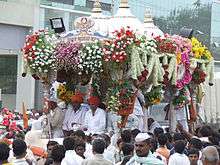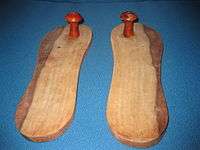Paduka

Paduka is the name of India's oldest, most quintessential footwear. It is little more than a sole with a post and knob, which is engaged between the big and second toe.[2]
It exists in a variety of forms and materials throughout India. They might be made in the shape of actual feet, or of fish, for example, and are made of wood, ivory and even silver. They are sometimes elaborately decorated. The more elaborate shoes could be part of a bride's trousseau, but could also be given as religious offerings or be themselves the object of veneration.[1]
Although simple wooden padukas could be worn by common people, padukas of fine teak, ebony and sandalwood, inlaid with ivory or wire, were a mark of the wearer's high status.[2]
Today paduka as footwear is generally worn by mendicants and saints of Hindu and Jain religions. Its significance in Hindu mythology is linked to the epic Ramayana. It also refers to the footprints of deities and saints that are venerated.[3][4][5][6]
Paduka also means foot prints of Hindu gods such as Vishnu, Shiva and other religious icons that are worshipped in this symbolic form in houses and also in temples built for this purpose. One such temple is the Gaya temple dedicated to Vishnupada or Vishnu's feet. Similarly, Buddha's foot prints are worshipped under the Bodhi tree in Bodh Gaya.[6][7]
It is also the royal symbol (not as a footwear but as a headgear) in Malaysia termed as ‘Seri Paduka’ denoting "His Majesty", which is a title bestowed as an honour of recognition to the dignitaries of Malaysian court for their outstanding contribution to the betterment of their State.[8]
Etymology
_-_Oct_2010.jpg)
Paduka is a compound word made up of two words namely, "pada" and "ka". In Sanskrit language, 'Pâda' means: "foot" (masculine noun) and ‘ka’ is a diminutive ending with literal meaning of "small". This terminology was coined to define India's ancient archetypal footwear.[1]
Legend
The word ‘pada’ (foot) is cited in the ancient Hindu scripture - Rigveda, as representing the universe namely the Prithvi (earth), Vayu (air), Akash (sky) and the element of the realm beyond the sky.[7]
In the Hindu epic Ramayana, King Dasaratha who had a curse on him, sent his son Rama (an incarnation of god Vishnu) for 14 years of exile, at the behest of his wife Kaikeyi (step mother of Rama) as she wanted her son Bharata to be crowned as the king. Rama, his consort Sita and brother Laksmana went into a forest to spend their period of exile. But Bharata did not want to have the kingdom. He, therefore, met Rama who was living in the forest and beseeched him to return to Ayodhya. When Rama told Bharata that he will return only after completing his fourteen years in the forest, Bharata requested for Rama's paduka to serve as his proxy, to be crowned in Ayodhya Raj Singhasan (King's throne) of Kosala country and to serve as an object of veneration for Rama's followers. Bharata carried Rama's golden sandals (padukas) with great reverence by placing them on his head as a mark of his obedience to his elder brother. Bharata ruled Kosala as Rama's proxy in the name of "Ram's Padukas".[7][8]
Sandal structure

The footwear is typically a sandal, which has generally a wooden sole with a post and a stub to provide grip to the foot between the big and second toes. It is also known as karrow, kharawan and karom and used in the Indian subcontinent mostly by mendicants, saints and common man for special occasions.[1] Made in the shape of the foot prints, with two narrow and curved stilts, the design is specific to ensure that the principle of non-violence - practised by the saintly followers of Hindu and Jain religions - is not violated by accidental trampling on insects and vegetation. The often heard prayer on the lips of a Brahmin wearing such a paduka is:"Forgive me Mother Earth the sin of injury, the violence I do, by placing my feet upon you this morning."[9]
Padukas made of ivory are a popular use among royalty and saints. These are, however, made from ivory of dead elephants or extracted from live domesticated elephants. Elephants are not killed for the purpose of making such sandals because Hindu religious ethos does not permit such cruel acts.[10] Padukas are also worn by common people. But people of high status in the society wear padukas made out of fine teak, ebony and sandalwood and inlaid with ivory or wire. It is also made in the shape of a fish, as a symbol of fertility.[11]
Other forms of padukas worn on special occasions are: Silver Paduka incised with silver or of wood covered with silver plates and sometimes adorned with bells to sound upon walking; Bronze Padukas and Brass Padukas with significance for ritual and ceremonial use.[12]
A unique pair of wooden padukas has toe knobs inlaid with ivory lotus flowers and is minutely painted. At each step, a trigger mechanism in the sole signals the lotus to open from bud to blossom. It is also made in the shape of an hourglass or with carved toes.[4]
An eighteenth-century footwear used as ritual wear made of "wood with bed of sharp iron spikes" has been found. It is inferred that it was meant to be used to inflict pain to the wearer to demonstrate his conviction in religious forbearance of pain.[4]
Veneration

Paduka is also gifted as part of a bride's dowry. They are worshipped and also given as votive offerings by the faithful believers.[9]
In a festival associated with the Hindu god Vithoba, pilgrims travel to his Pandharpur temple from Alandi and Dehu towns that are closely associated with poet-saints Dnyaneshwar and Tukaram respectively, carrying the Padukas of the saints in a silver palkhi (palanquin).
The popular religious belief is that of the contact (sparsh) with the Salabhanjika yakshini's foot. It is said that when the Yakshini encircles a dormant tree with her leg around it, it starts to blossom and bear fruit. Shalabhanjika yakshi is also an embellishment in the form of an architectural bracket in many Hindu temples.[7]
Another notable feature of veneration is of goddess Lakshmi, the goddess of prosperity. On Deepavali festival day, Lakshmi is devotionally ushered into the house by symbolic representation with a series of her foot prints (paduka) drawn in paint or kolam and lighted all along with oil lamps, from the main door of the house into the private sanctum in the house. This is done with the prayerful wish that good fortune shall be bestowed by her on the householders.[5]
Below the Bodhi tree at Bodh Gaya where Buddha got enlightenment, there is a vacant throne that is adorned with the foot prints on a foot rest of the Buddha. This place is deeply venerated.[7]
- Vishnupad temple

Vishnupada Mandir is said to enshrine the footprints of god Vishnu.[13] This footprint denotes the act of Vishnu subduing Gayasur by placing his foot on Gayasur's chest. Inside the temple, the 40 centimetres (16 in) long footprint of Vishnu is imprinted in solid rock and surrounded by a silver-plated octagonal open enclosure.[14] The temple is 30 metres (98 ft)in height and has 8 rows of elegantly carved pillars that support the pavilion.[15] Within the temple precincts, the banyan tree called the 'Akshayabat' is located where the final rituals for the dead takes place.
- Paduka Sahasram
Paduka Sahasram, literal meaning "1000 verses on the padukas of the Lord", is devotional poetry extolling the virtues of worshipping the Paduka (feet) of god Vishnu whose deity is enshrined in Sri Ranganathaswamy Temple in Srirangam in Tamil Nadu. It is considered a sacred script of the Sri Sampradaya or Sri Vaishnavism, who are known by the surname Iyengar, also spelt Ayyangar in South India. The Sahasram was composed in 1008 verses in 32 chapters by Swami Vedantha Desika, a follower of the Vishishtadvaita philosophy propounded by saint Ramanujacharya. It is also said that Desika composed this magnamopus, as a challenge to his rival group of Tengalai Iyengars (Iyengars belonging to the southern school of the Srivaishnava philosophy), in one yamam of a night meaning one quarter of a night, which was acclaimed as a master piece of religious poetry and he was awarded the title of Mahakavi. The eulogy of the Lord's Paduka by Desika is spun around Rama's sandals (Paduka), which ruled the kingdom of Ayodhya for 14 years. He propounds that it was due to the special relationship that people of Ayodhya had with Rama's Paduka that they attained liberation, meaning salvation in life.[16][17]
- Guru Paduka Sthothram
Adi Shankaracharya has also written nine devotional verses under the title "Guru Paduka Sthothram" as salutations to his guru, in this case meaning the Lord. The English language translation of the first verse means:[18]
Salutations and Salutations to the sandals of my Guru,
Which is a boat, which helps me, cross the endless ocean of life,
Which endows me, with the sense of devotion to my Guru,
And by worship of which, I attain the dominion of renunciation.
References
- 1 2 3 4 "britishmuseum.org".
- 1 2 All About Shoes - The Bata Shoe Museum
- ↑ "The Paduka". Retrieved 2009-12-26.
- 1 2 3 "Paduka". Fashion Encyclopedia. Retrieved 2009-12-26.
- 1 2 "Feet and Footwear in the Indian Tradition". Retrieved 2009-12-26.
- 1 2 Monier Monier-Williams. "Sankrit Lexicon". p. 618. Retrieved 2009-12-27.
- 1 2 3 4 5 "In the Footsteps of the Divine". Retrieved 2009-12-26.
- 1 2 Kampar (1969). Sri Paduka: the exile of the Prince of Ayodhya. Paduka. Ohio University, Center for International Studies. pp. 3, 4. Retrieved 2009-12-26.
- 1 2 "The Paduka". Retrieved 2009-12-26.
- ↑ "The Ivory Padukas". Retrieved 2009-12-26.
- ↑ "The sandalwood Padukas". Retrieved 2009-12-26.
- ↑ "Metal Padukas". Retrieved 2009-12-26.
- ↑ "Vishnupad Temple". Retrieved 2009-12-26.
- ↑ "Discover Bihar". Archived from the original on 24 September 2009. Retrieved 2009-12-26.
- ↑ < "About Gaya". Retrieved 2009-12-26.
- ↑ "Swami Swami Desikan's Sri Ranganatha Paadhuka Sahsram". Annotated Translation into English by Oppilippan Koil Sri Varadachari Sahtakopan. Scribd. Retrieved 2009-12-29.
- ↑ "Mediating role". The Hindu. 2006-09-20. Retrieved 2009-12-29.
- ↑ "Guru Paduka stotram". Retrieved 2009-12-29.